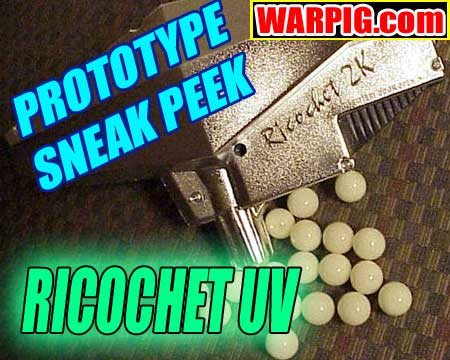  |
|
|
|
|
|
|
  |
|
|
|
|
|
|

What
do you think?
|

Ricochet UV Sneak Preview
Sometimes a good concept can take years to be refined. In 1987, paintball distributor and retailer Aerostar added chemical glowstics to their catalog with a short paragraph describing how to cut open the glowsticks and roll paintballs in the chemical mix for a ball that was visible in flight at night. Neat idea, and the paint did glow in the hopper, but the balls move fast enough in flight that it was barely visible. In the early 1990s a paint manufacturer came out with a fluorescent fill designed to glow brightly under black lights for indoor play. Unfortunately, the practicality of lighting an outdoor field, or an entire indoor field with enough ultraviolet light to make that effective was not very realistic.
At the 2001 International Amateur Open Paintball 2 Xtremes assistant editor Josh Silverman introduced me to Paul Ciesun of Wreched Seven Paintball. Paul was in the process of developing a glowing paintball fill for night play that would charge under ultraviolet lights, and glow long enough to carry onto the field, and use while still glowing brightly enough to be very visible in flight. Paul ended up working with Xtreme Enterprises who encapsulated his glowing fill into the Crypt-O-Night paintball, which began appearing at a number of scenario games that winter and fall.
At the 2002 San Diego Pan Am Tournament, Ennis Rushton of Ricochet Development, LLC. decided to give WARPIG.com readers an exclusive first look at his solution - the Ricochet UV. The Ricochet UV incorporates an ultraviolet light source inside a Ricochet loader that has an interior chromed surface. According to Rushton it's a combination of the efficient UV tube and the angled reflective walls of the loader that lead to very efficient charging of the Crypt-O-Nite paintballs. While the prototype was built into a Ricochet 2K loader, Rushton says the production models will be in a body more similar to the Ricochet AK, and will not feature timer electronics in the back. The UV will be available in a basic non-electronic hopper version for indoor and scenario field rental running on a single 9 volt battery, as well as an agitating version using the Ricochet AK agitator system running on a 9 volt, and a dual "AA" penlight battery pack for the UV lamp that will slide onto the hopper in place of the normal Ricochet AK battery cover.
The Ricochet UV is expected to be available
in limited quantities in late summer 2002 with full volumes shipping by
mid fall. The agitating version of the Ricochet UV is expected to
retail for around $80 with the non-agitating version substantially lower.
Since the UV lamps can be switched off to prevent battery drain, the Ricochet
UV will do double duty as a loader for normal paintball play, as well as
when charging the Crypt-O-Nite paint.
|
| Copyright © 1992-2019
Corinthian Media Services. WARPIG's webmasters can be reached through our feedback form. All articles and images are copyrighted and may not be redistributed without the written permission of their original creators and Corinthian Media Services. The WARPIG paintball page is a collection of information and pointers to sources from around the internet and other locations. As such, Corinthian Media Services makes no claims to the trustworthiness or reliability of said information. The information contained in, and referenced by WARPIG, should not be used as a substitute for safety information from trained professionals in the paintball industry. |